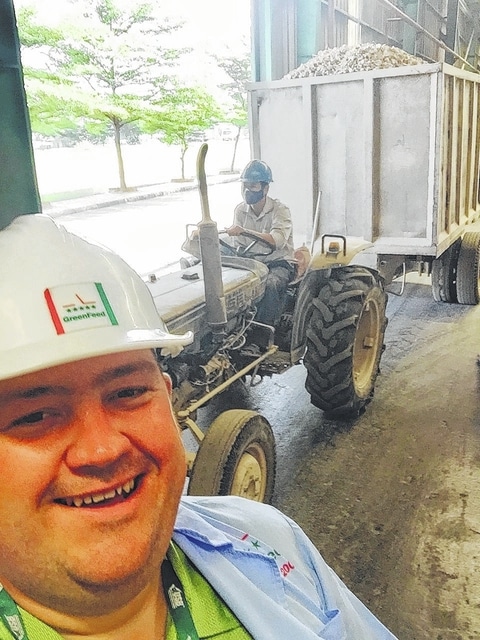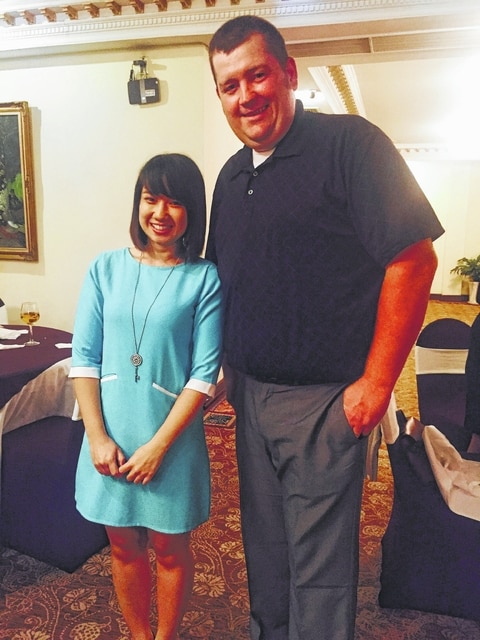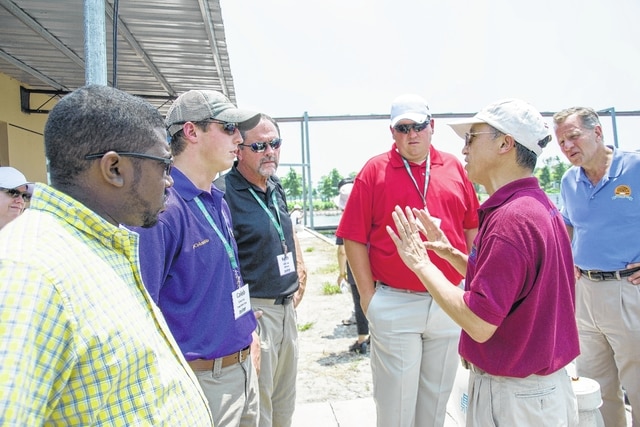


NEW VIENNA — Where farmer Nathan Brown’s soybeans go matters. For a whole lot of reasons.
That is why the area soybean grower recently took part in a week-long trip to Southeast Asia to see not only where his soybeans (and the soybeans of thousands of other American growers) are used but also where his “checkoff” dollars go.
Brown said the trip to Shanghai, China and Vietnam, sponsored by the U.S. Soybean Council, was an “eye-opening trip.” It was the first time he had traveled overseas.
“I got kind of nervous when I opened the letter saying, ‘Congratulations, you have been selected to participate in our trip to Southeast Asia.’ In the past they had gone to places like South America,” Brown said.
Brown was one of 10 farmers from across the U.S. to take this year’s annual trip, which took place in late summer. He said farmers from across the country apply to take part in the “See For Yourself” program.
The program’s aim is to show them where their “checkoff” dollars are being spent and what happens to their soybeans when they are exported to a foreign market. “Checkoff” program funds from each producer’s annual sale of soybeans. The board spends this money on soybean research and development, as well as growing the export market and finding new uses for soybeans.
Brown, president of the Highland County Farm Bureau, has a 115-acre farm with his wife Jennifer, in Highland County, near New Vienna. In total, he farms about 1,100 acres.
St. Louis to Shanghai
After visiting research facilities in St. Louis, Brown and the other nine soybean farmers flew across the Pacific and visited “aquaculture” facilities near Shanghai and outside of Ho Chi Minh City.
“When we landed in Shanghai, we met with the U.S. Soybean Export Council members who are stationed there. These are the people who really have the boots on the ground in these countries. They have several offices in China,” Brown said.
What was Brown’s reaction to Shanghai, the most populated city in the world? “There are 24 and half million people who live in Shanghai. The number of people there, the buildings … for someone who lives on 155 acres where you can hardly even see your neighbors, that was quite a shock,” he said.
They were in Shanghai for three days.
“We went to a Chinese research farm to see their aquaculture facilities. The Soybean Council has been working with the Chinese, teaching them new ways to increase production. In return, this increases the use of soybeans, since soybean meal is used to feed the fish,” he said.
That is why the soybean farmers toured aquaculture — or fish farm — facilities. These fish farms raise a variety of fish including tilapia and catfish.
“One of the neat things was that we were able to see the containers filled with soybeans being unloaded at their facilities. These were containers like the ones I’ve seen being loaded here (in Ohio) with soybeans. It linked home and China together,” Brown said.
“The fish farm system used by the Chinese growers was developed by the University of Arkansas. That system was then taken by the Soybean Council to the Chinese. It was kind of a double-edged sword. Some U.S. aquaculture facilities in the south were a little upset by the Soybean Council doing this. On the one hand we are increasing our soybean demand by showing the Chinese this method, but then we are also losing business from our aquaculture farms,” Brown pointed out.
Growing demand in Vietnam
After three days the group then traveled to Vietnam, landing in Ho Chi Minh City. He called Vietnam, “A very, very beautiful country.”
They visited the “InterFlour” production facility in Vietnam at the Cai Mep Port, where American soybeans are unloaded, processed and then used to feed their aquaculture pond fish, which number in the millions. They toured Vinhhoah Corp., which was a fish farm, feed mill and production facility. They also toured the GreenFeed feedmill, one of the largest in Southeast Asia. All of them process soybean-based feed.
“There is such a growing demand for soybeans in Vietnam, and such a desire for proteins in all of Southeast Asia,” Brown said. While small, Brown said there is a partnership between the U.S. and Vietnam, for trade.
How much of their soybeans come from the U.S.? “Perhaps a little more than 50 percent in China. In Vietnam, maybe five to 10 percent. They want U.S. soybeans because they are better quality beans with higher protein levels. But it all comes back to price. It is cheaper from South America. Tariffs and the value of the dollar affect this difference in prices,” said Brown.
Surprises and relationships
What surprised him the most on his trip? “I think seeing firsthand American technology that we developed here for our production and taken over there to help their production. But in the end it is helping our markets, so why not teach them better farming practices? The population will only continue to grow. We are in a prime location here in America to feed the world with our crops, but can we continue to do that throughout the world? It is good to see that they are adapting new practices and learning to feed themselves,” said Brown.
“It was a very worthwhile trip. If I had the opportunity to return as part of a trade mission, to help build relationships, I would.”
And Brown believes that building relationships with farmers and producers in China and Vietnam may be the most important thing that comes from these trips. As Brown looked through all the photos on his computer taken during his trip, he pointed out one photo after another of him standing with Vietnamese farmers and business people, many of them who receive the soybeans that he produces. They were always smiling.
“Building relationships is better than the dollar sometimes. That’s why it is important to be active and involved in the Soybean Council. I highly encourage any soybean producer to apply for the program,” Brown said.




